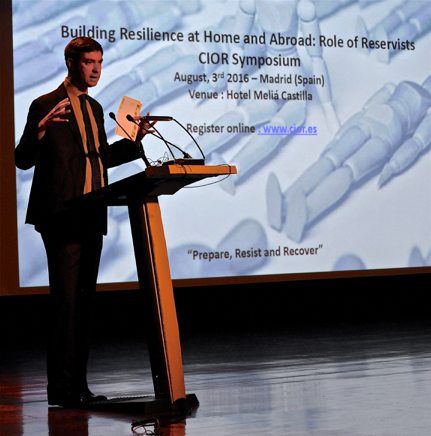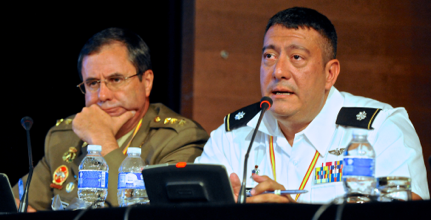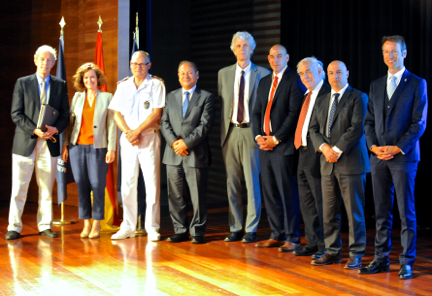Recent major changes in our security environment have made mandatory the study of new concepts. New buzzwords have appeared that try to define, or at least reveal, a shift of paradigm. Among those, “resilience” has gained interest, as it aims at helping individuals, systems and societies, to recover after any kind of unprecedented, unpredictable and catastrophic shock. In an era where the level of threats and risks questions the ability of stakeholders, government and international organizations to protect their population, building and maintaining resilience has become a key issue.
The Symposium of the Interallied Confederation of Reserve Officers (CIOR), held in Madrid on August 2nd, 2016, pursued a dual objective: not only to inform the over 230 participants, but also help them to understand their potential role.
Opened by LtCol Dimitar Popov (BUL A), President of CIOR, and under the direction of Dr. Guillaume Lasconjarias of the NATO Defense College (Rome, Italy), the Symposium was divided into three sessions.

The first panel was meant to serve as an overview of the current geopolitical changes and the evolution of threats. The brilliant demonstration of Col Sanchez de Rojas (CESEDEN – SPA) offered a grim, nonetheless realistic, image of today’s security and operating environment. However, Maj Estevez of the Spanish MILREP (SPA A) insisted on the continuous ability of NATO to adapt and offered a view as much as an update on the outcomes of the Alliance’s Warsaw Summit that was held in Poland early July.

Without negating the challenges NATO faces, these presentations highlighted how NATO’s members and partners still are relevant and can run the gauntlet vis-à-vis any potential adversaries or competitors defending its core values through a revised focus on collective defense and Article 5 of the Washington Treaty.
This introduction set the stage for the participants, helping them to understand in which environment they would have to operate – as much as the environment in which they live. Dr Lasconjarias, followed by Col Segovia (SPA A), both tried to define not just what resilience meant in the academic field but shared their thoughts on what resilience is today. Defining the concept as being in the same time the ability to recover, to adapt and to mitigate after a shock. They also discussed why
NATO takes this concept seriously.

From a purely military perspective, resilience is a key requirement as it aims at limiting the vulnerability of infrastructures, systems and individuals, and therefore, enabling the pursuit of military operations. Case studies followed, introduced by LtCol Pulido (SPA A), who explained the particular case of cyber resilience, a vital asset in our connected world.
Mark Cumo (USA CIV), from the Counter-IED Centre of Excellence in Madrid, emphasized how even a technical and tactical issue like IED has to be addressed in a comprehensive way.

Finally, LtCol Bruno (USAF, and CIOMR) recalled that resilience starts with individuals and gave the example of how the US Armed forces have developed a wide array of programs to help their soldiers in being more resilient and thus, more resistant.
The afternoon, under the chairmanship of Navy Captain (R) Richard Roll (FRA N), past President, envisioned resilience from the civilian perspective, trying to answer a key question about how civilian entities would also get the best use of reservists in their unique ability to be “twice a citizen.” An impressive panel of experts was convened.
Benny Vaknin (ISR), former mayor of Ashkelon, shared his lessons learned in dealing with an almost permanent threat, and which tools and skills are critically needed to steer a city and lead a community.
Nicolas Wit, of Citées Unies France, insisted on how local governments can already share their expertise and tools to be better prepared, a view that Chris Geldart, of Washington, DC’s Homeland Security and Emergency Management Agency totally shared.
At an international level, Ms Lucia Fernandez Suarez gave the example of the World Food Programme and its unique program to develop food security through resilience. The dimension of protecting systems and critical infrastructures was not forgotten and Francisco Cubillo illustrated how Spain focuses on water security through the protection of Canal Isabel II, seen as a strategic asset.
Professor Ilan Juran, former Dean of New York University, and Chairman of W-Smart, an association of utilities promoting resiliency in the field of water and energy, finished in observing that resilience can only work if people take it seriously and train and educate themselves to be prepared.
Dr Antoni Esteve, head of FarmaIndustria and Anna Bolletbo, president of the International Foundation Olof Palme, insisted on the necessary awareness and the ties and links that have to be built between different actors, in a time where defense can only be seen as a comprehensive and inclusive whole-of-government approach, which needs to also take stock of the skills and competencies present in the private sector.

This, once again, confirms that resilience is more than a buzzword – it is an attitude, a behavior, and a relationship. In this field it seems now more than ever, important to take a closer look at how reservists, due to their unique position in bridging the gap between military and civilian spheres, can help safeguard our open societies and democracies.
Author:
Dr. Guillaume Lasconjarias
NATO Defense College
Photos by:
Captain Henry E. Plimack
USCGR (Ret)
